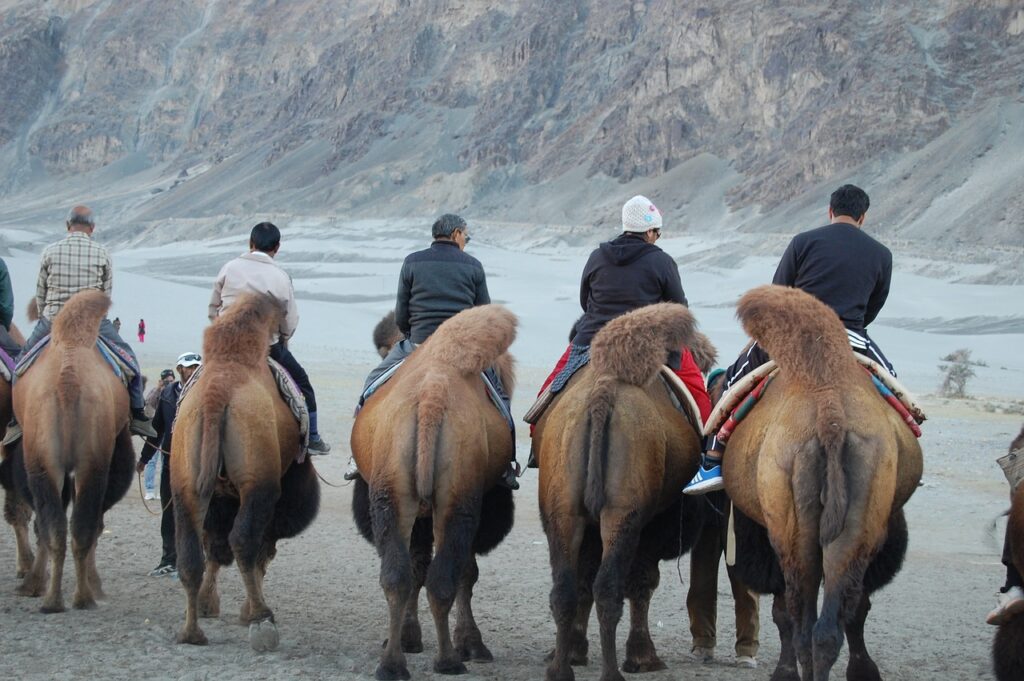Once upon a time, nestled in the heart of Ladakh, there existed a breathtaking valley that was as mysterious as it was enchanting – the Nubra Valley. For those who ventured into Ladakh for the first time, this valley was a must-see. It wasn’t just another part of the landscape but a wonder that stood out amidst the rugged terrain. The Nubra and Shyok rivers cut their way through the valley, creating what locals referred to as a “tri-armed valley,” a land with three distinct arms extending in different directions.
Long ago, the valley was known by its Tibetan name, Ldumra, meaning the “flower valley.” But it wasn’t just any valley of flowers. It was one of the most stunning regions in Ladakh, often compared to lunar landscapes. A cold desert, yet full of life, the Nubra Valley’s barren hills and unique beauty captivated travelers from across the world.
The three arms of the valley held different stories. One was the Nubra River Valley, divided into three portions known as Yarma, Turka, and Farka. Then, there was Gyen, the upper Shyok Valley, and finally Shama, the lower Shyok Valley that stretched to the Chorbat region. Although the valley was mostly dry and devoid of much vegetation, along the riverbeds, life thrived. Villages in Nubra grew wheat, barley, peas, and mustard, and orchards bore fruit like blood apples, walnuts, apricots, and even almonds, nurtured by the fertile land along the rivers.
But Nubra wasn’t just about the crops and the rivers. It was the pride of Ladakh. One could wander through ancient monasteries, feel the magic of the white sand dunes, or explore remote settlements. Among these was the renowned Diskit Monastery, standing majestically on a hill, overlooking the valley. Built in the 14th century, this grand monastery had a statue of Maitreya Buddha, towering 32 meters high. The Buddha, facing west toward Pakistan, was said to protect the land, promote peace, and prevent further conflicts. It was a sight that filled hearts with awe.
Not far from the monastery, the sand dunes of Hunder mesmerized all who laid eyes on them. Their ever-changing shapes enchanted visitors, but it was the rare, double-humped Bactrian camels that truly made the experience unforgettable. These gentle creatures took visitors on rides across the dunes, their swaying movement adding an extra touch of magic to the already surreal landscape.
And for the adventurous souls, Hunder offered more thrills in the form of quad-biking. Riding through the dunes on an ATV was an adrenaline rush unlike any other, with the wind rushing past and the mighty mountains serving as a backdrop.
Beyond Hunder, other treasures of Nubra awaited. The Samstanling Gompa in Sumur was a peaceful haven with its vibrant colors and serene surroundings. The Yarab Tso Lake, tucked away in the mountains, was a hidden gem that could only be reached by trekking. Its crystal-clear waters reflected the mountains around it, leaving every visitor in awe of its serene beauty.
Turtuk, a village on the edge of India’s borders, told a tale of history, being the last settlement before Pakistan’s Baltistan. Nearby, Panamik village, known for its sulfur-rich hot springs, offered relaxation in the shadow of the Siachen Glacier. Here, one could shop for exquisite Pashmina shawls or indulge in local dried fruits while soaking in the beauty of the high-altitude landscape.
Nubra wasn’t just about its scenic spots or its historical significance. The valley was home to a unique ecosystem. Its shrub woodlands, famously known as Leh Berry, provided shelter to rare birds like the white-browed tit-warbler, Tibetan lark, and Hume’s short-toed lark. In the waters along the valley, ruddy shelducks, pintails, and mallards floated gracefully, while waders like the common sandpiper and redshank tiptoed through the shallows.
And if all this wasn’t enough, the Nubra Valley could now be visited year-round, thanks to the road that crossed over Khardung La, the highest motorable civilian pass in the world. Whether you chose to visit in the warm months of April to June, or the serene autumn of September to October, Nubra Valley had something to offer every traveler.
Just a short 150 to 160 kilometers away from Leh, the valley was an escape into another world. Historically, the routes from Nubra to Baltistan and Yarkand had been important trade routes, but these had been closed off in the mid-20th century. Yet, Nubra still retained its significance, drawing in explorers and dreamers alike.
Whether it was camping luxuriously at the Nubra Ethnic Camp in Hunder or admiring the wilderness of the valley at the Valley Flower Camp in Sumur, visitors left Nubra with memories etched into their hearts. The valley, with its mystical aura and undeniable beauty, was a place where time stood still, and every moment was filled with wonder.
And so, Nubra Valley, with its towering monasteries, ancient villages, and breathtaking landscapes, remained one of the most cherished gems of Ladakh, calling to all those who sought adventure, peace, and beauty.

